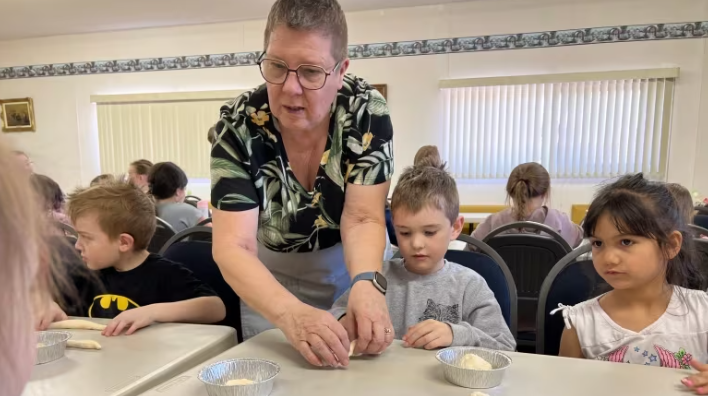Already struggling, this Alberta village faces losing its only school

Trustees with Elk Island Public Schools considering a motion to close Andrew School
Carol Dubitz has spent much of her life around Andrew School in Andrew, Alta. She attended the school herself. Her children, now grown, also went there.
These days, Dubitz looks after a small shop, a bowling alley, sauna and gym in the same building as the school.
This week, she’s worried.
At a special board meeting on Thursday, trustees with Sherwood Park-based Elk Island Public Schools will consider a motion to close Andrew School, the only school in the village of fewer than 400 people, 115 kilometres northeast of Edmonton.
If a decision is made to close the school, it would close by the end of this academic year. Next fall, students would be bused to nearby Mundare or Lamont.
“It’s sad to see these small towns dying off, where it took a lot of work and people to make these towns,” Dubitz said in an interview.
“If we don’t have anything to bring people into this town, we don’t have a town.”
School at the end of its life
Andrew’s school has two major problems: the building is “at the end of its functional life,” according to a recent report, and enrolment is in steep decline.
Although the school has capacity for 385 students, only 62 are attending this year, in kindergarten through Grade 6. In 2019, the school stopped offering high school grades, and a year later, junior high.
Enrolment is expected to plunge further next year to 44, with only three kids in kindergarten.
The building — originally constructed in 1957 with additions in 1964, 1980 and 1991 — has a “questionable” sprinkler system and leaky roof, with total repairs estimated at more than $3.2 million, according to an April report to the board from EIPS administration.
“The government of Alberta does not provide emergent funding for repairs of this kind; school divisions are expected to pay with existing resources,” an EIPS spokesperson said in an email to CBC News.
The school division owns the school and the land it sits on. The Village of Andrew owns an adjoining building, which includes the village offices, the public library and a two-lane bowling alley.
Together, EIPS and the village share financial responsibility for repairs and upkeep of the whole building — EIPS is responsible for two-thirds of the costs, with the village responsible for the rest.
Village population also dwindling
The falling enrolment at Andrew School reflects a similar issue in the village itself. According to the EIPS report, Andrew’s population fell about 14 per cent between 2016 and 2021.
Locals are concerned about the impact losing the school would have on the community.
“Loss of the school would be absolutely devastating,” said Vanessa Ostashek, a member of the Rainbow Club for seniors in Andrew.
Ostashek recently taught elementary students from the school how to make paska, a Ukrainian Easter bread. The activity is an example of how older Andrew residents help younger generations learn about the community’s rich Ukrainian history.
If the kids are going to school elsewhere, this kind of activity might not happen in the village, Ostashek said.
“We wouldn’t have the relationship with the children and seniors as we do now because the children wouldn’t be here and there would be no reason for families to move out here.”
If trustees vote to close the school, the division could offer to sell the property at market rate, with the approval of the education minister.
It could also decide to transfer the building and the land to the village, again with the minister’s approval.
And ultimately, if no one wants it, EIPS may be responsible for the cost of demolishing the school, estimated at more than $400,000.
Troubles facing Andrew
The village is facing significant problems, financial and otherwise. The village council has asked the provincial government for a municipal inspection.
“It is very challenging and overwhelming at times for this council,” Mayor Merwin Haight said in an interview.
“We seem to be constantly hit with another new challenge before we can even settle a previous one.”
Property values in Andrew have fallen by as much as 50 per cent since pre-COVID, Haight said. It’s possible to buy a three-bedroom house in the village for less than $100,000.
Kal Baroudi, owner of Centre Town Auto Body in Andrew, is worried about losing the school.
“If the school’s gone, families will start to move out of here. We lose everything we worked hard for,” Baroudi said.
“We work hard to retire to have a better future, better life for our kids, for our grandkids. Everything that we worked hard for, if we lose [the school], we lose everything.”
What comes next
The Village of Andrew is exploring its options in the event the school is slated to close. One option is to start a new school.
In 2020, the Village of Holden, 70 km south of Andrew, lost its school. The community rallied and in 2022, opened the first rural charter high school in the province.
“Because kids are heading off to bigger centres, all of a sudden we’re losing rural Alberta,” said Brian Dewar, principal of Holden Rural Academy.
Holden’s new school has 64 students with an additional 13 new enrolments for next school year.
Dewar credits the school’s success to a more hands-on learning approach. For example, students can learn mechanical skills, cow calving and crop operations to help out on the family farm.
Haight plans to visit Holden to see if something similar could work in Andrew.
Related News
Canadians required to register with U.S. government if in country at least 30 days
Many Canadians travelling to the United States will now have to newly register with theRead more
Duty-free shops struggle to make ends meet as Canadians steer clear of U.S.
If business doesn’t pick up soon at his duty-shop, Éric Lapointe says he’s going toRead more
